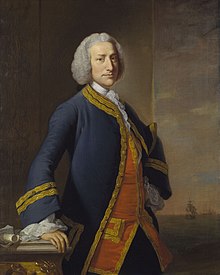
Back چورچ انسون ARZ Джордж Ансън Bulgarian George Anson Catalan George Anson Czech George Anson, 1. Baron Anson German George Anson (almirante) Spanish جورج آنسون، اولین بارون آنسون Persian George Anson (paroni) Finnish George Anson French George Anson Galician
The Lord Anson | |
|---|---|
 Portrait of Lord Anson by Thomas Hudson | |
| First Lord of the Admiralty | |
| In office 1757–1762 | |
| Prime Minister | The Duke of Newcastle The Earl of Bute |
| Preceded by | The Earl of Winchilsea and Nottingham |
| Succeeded by | The Earl of Halifax |
| In office 1751–1756 | |
| Prime Minister | Henry Pelham The Duke of Newcastle |
| Preceded by | The Earl of Sandwich |
| Succeeded by | The Earl Temple |
| Personal details | |
| Born | 23 April 1697[1] Staffordshire, England |
| Died | 6 June 1762 (aged 65) Moor Park, Hertfordshire, England |
| Military service | |
| Allegiance | |
| Branch/service | |
| Years of service | 1711–1762 |
| Rank | Admiral of the Fleet |
| Commands | HMS Weazel HMS Scarborough HMS Garland HMS Diamond HMS Squirrel HMS Centurion |
| Battles/wars | War of the Spanish Succession War of the Quadruple Alliance War of Jenkins' Ear War of the Austrian Succession Seven Years' War |
Admiral of the Fleet George Anson, 1st Baron Anson, PC, FRS (23 April 1697 – 6 June 1762) was a British Royal Navy officer, politician and peer from the Anson family.
He served as a junior officer during the War of the Spanish Succession and then saw active service against Spain at the Battle of Cape Passaro, off the south tip of Sicily, during the War of the Quadruple Alliance. He then undertook a circumnavigation of the globe during the War of Jenkins' Ear. Anson commanded the fleet that defeated the French Admiral de la Jonquière at the First Battle of Cape Finisterre in 1747, during the War of the Austrian Succession.
Anson went on to be First Lord of the Admiralty during the Seven Years' War. Among his reforms were the removal of corrupt defence contractors, improved medical care, submitting a revision of the Articles of War to Parliament to tighten discipline throughout the Navy, uniforms for commissioned officers, the transfer of the Marines from Army to Navy authority, and a system for rating ships according to their number of guns.